
The Hollinwood Branch left the mainline of the Ashton Canal at Fairfield Junction, Droylsden, just above lock 18. It was 4 miles 52 chains long and it terminated at Hardman Fold Basin (aka Hollinwood Basin), Hollinwood, where there was a junction with the privately owned Chamber Colliery Company's Werneth Branch, which was about 650-yards long. The branch climbed through four locks at Daisy Nook* (Waterhouses locks) and another four locks at Hollinwood (Hollinwood locks), which raised it to the short summit pound. There were three aqueducts, these being located over the Lancashire & Yorkshire Railway line (Littlemoss Aqueduct at Littlemoss), over the river Medlock (Waterhouses Aqueduct at Daisy Nook) and over Crime Ln (Iron Aqueduct at Daisy Nook). A canal link to the nearby Rochdale Canal was proposed shortly after the Hollinewood Brasnch opened but this was never built.
Waterhouses Junction was situated immediately above lock 22 and from here the Fairbottom Branch ran eastwards through Bardsley to terminate at Fenny Field Bridge. This branch was 1 mile 11 chains long and it had one aqueduct (Valley Aqueduct) over a lane. Three tramways were connected to this branch. The first was from Woodpark Colliery, Bardsley and it joined the branch adjacent to Waterhouses Junction. The second was from the Diamond Pit of the Bardsley Colliery Company and it joined the branch just beyond Valley Aqueduct. The third was the Park Bridge Tramway from Rocher Colliery and it joined the branch just before its terminus at Fenny Field Bridge. This tramway also served the Park Bridge Iron Works founded by Samuel Lees in 1786 and later expanded by his widow, Hannah Lees née Buckley.
On the Hollinwood Branch Canal from c.1850, Oak Colliery (Victoria and Albert Pits) was connected by tramway to Bradley Bent Basin immediately below Lock 23. This was a self-acting incline plane where descending waggons full of coal hauled ascending empty waggons back to the colliery under the action of gravity. There were also tramway connections to the adjoining Brook Mills, Nos 1 & 2.
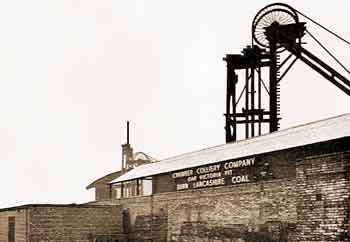
Oak Colliery, late 1930s.
Victoria Pit is in the foreground and Albert Pit is in the background.
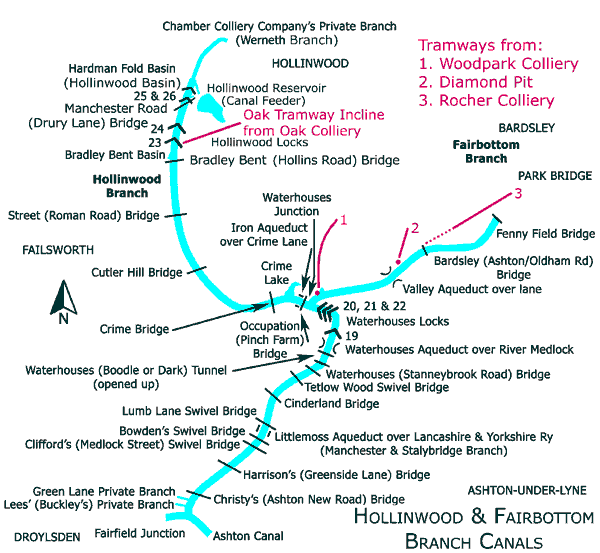
The foremost purpose of the two branches was to serve collieries in the vicinity, the coal being carried to neighbouring mills. Coal was also carried into Manchester for both industrial and domestic use.
| From | By Canal | By Road |
|---|---|---|
| Ashton Canal, including Hollinwood & Fairbottom Branches | 200,400 (39.30%) | |
| Manchester, Bolton & Bury Canal | 120,552 (23.64%) | |
| Rochdale Canal | 55,388 (10.86%) | |
| Bridgewater Canal | 43,305 (8.46%) | |
| Oldham | 81,354 (15.96%) | |
| Rochdale | 9,100 (1.78%) | |
| Total carried by canal & road = 510,099 tons | ||
Up until the early 1920s the Hollinwood and Fairbottom Branches were extensively used but mining subsidence had long been a problem and in time Waterhouses Tunnel began causing difficulties as well. The solution for the tunnel was to gradually remove the overlying ground over a period of several years and it was not until the 1920s that this work was completed to leave the canal in a deep cutting where the tunnel had once been. The solution to mining subsidence proved to be intractable and the only way of coping with this problem was to keep raising the banks of the canal. Opening up the tunnel and the raising of canal banks were both expensive procedures that had to be contrasted with falling revenues.
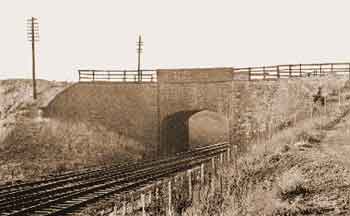 |
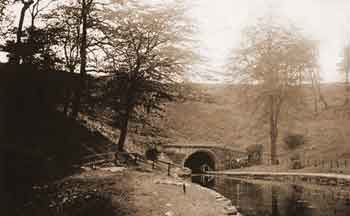 |
Littlemoss Aqueduct carrying the Hollinwood Branch over the Lancashire & Yorkshire Railway line (Manchester & Stalybridge Branch, 1964. It was demolished in the same year. Credit: C K Potter Archive. |
The north portal of Waterhouses (Boodle or Dark) Tunnel on the Hollinwood Branch, early 20th century. The tunnel was 66-yards long and there was a towpath through it. The minimum height above water level was 9 feet 1 inch and the minimum width was 8 feet 1 inch. |
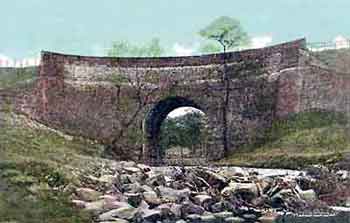 |
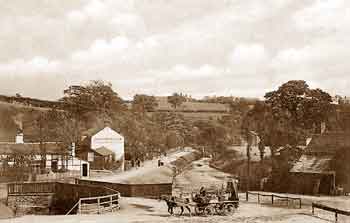 |
Waterhouses Aqueduct, early 20th century. This single-arched aqueduct stands 80 feet above the river Medlock on the Hollinwood Branch and it is curved deeply inwards in plan, the walls are battered and there is a buttress on each abutment. The deep curvature of the walls form arches in plan and this enables the aqueduct to withstand both water pressure and earth pressure from the steep sides of the valley. The river Medlock flows under the aqueduct on an inverted arch. Waterhouses Aqueduct is listed Grade II, List Entry No. 1356454. |
Daisy Nook, early 20th century. The bridge in the left foreground crosses the river Medlock and on the far side the white gable end has ‘DAISY NOOK VIEW’ marked on it. This terrace was originally known as Ben Brierley Terrace after Benjamin Brierley the Failsworth writer and poet whose pen name was Ab-o’th’-Yate’. Originally, the terrace consisted of three cottages but here Joseph Buckley, a photographer from Ashton-under-Lyne, converted them into his photographic studios and dining rooms. Joseph Buckley was known as 'Owd Ab' and the former cottages as 'Owd Ab’s Cottage'. The single-storey, timber-framed building in the left foreground is the ‘Hen Cote’ that was used as refreshment rooms. |
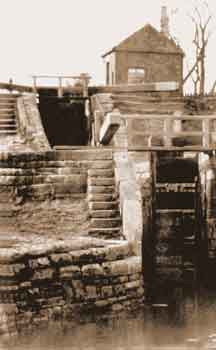 |
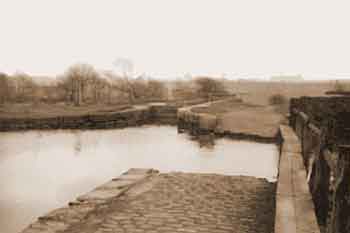 |
Locks 20 and 21 at Daisy Nook on the Hollinwood Branch, c.1920. These locks formed a staircase pair, that is, the top gate of lock 20 was also the bottom gate of lock 21. |
Lock 22 at Daisy Nook, 1964. Above lock 22 the Hollinwood Branch arrives at Waterhouses Junction where the Fairbottom Branch is off the picture to the left. The spillway on the right drains excess water from the canal in the event of a flash flood. Water flowed down the valley side to discharge into the river Medlock. The footbridge carrying the towpath over the spillway is supported by stone plinths. Credit: C K Potter Archive. |
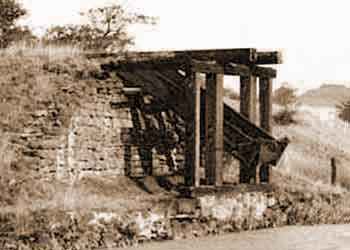 |
Woodpark Colliery tramway loading staithe on the Fairbottom Branch adjoining Waterhouses Junction, c.1950. |
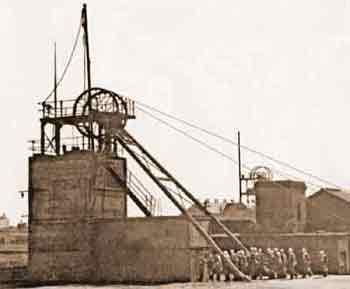
Woodpark Colliery, Bardsley, early 1950s.
This colliery was located on the corner of Oldham Road (now Ashton Road) and Coal Pit Lane.
It was sunk in c.1836 but the sequence of ensuing operators is uncertain. It is understood that Messrs Leeses & Booth worked the colliery between 1860 and 1865 and that by c.1873 it was being worked by the Chamber Colliery Co who were there until 1947 when it was nationalised. Due to the proximity of the colliery to Ashton Moss and Bradford Collieries it was decided to close the colliery in March 1955 and work the mines from the latter two collieries.
Prior to 1860 Woodpark Colliery was comprised of Copperas House Deep Pit and Copperas House Colliery. The Great Mine was worked between 1938 and 1944 when the Arley Mine was developed. After the nationalisation of Woodpark Colliery in 1947 the Colonel Mine was worked and the Arley Mine was discontinued in 1950. Other mines worked included the Black, New, Old Man, Peacock, Roger and Two-foot.
By the mid-1920s it was becoming apparent that the two branches were approaching the end of their industrial life. The canal maintenance team of the London and North Eastern Railway Company were based at the Gorton Canal Depot on the Stockport Branch and this was led by Inspector George Lucas. His team was divided into several gangs that were required to provide maintenance cover for the Ashton, Peak Forest and Macclesfield Canals but to these experienced workmen the Hollinwood and Fairbottom Branches were an everlasting irritation, principally due to mining subsidence. By 1904 the Fairbottom Branch Canal above Bardsley Bridge had been abandoned because mining subsidence in the vicinity of the bridgehad reduced its headroom to four feet.
Most of the remaining traffic was concerned with the transportation of coal and because of this, tireless endeavours were made to keep the condition of the canals to a minimum standard. Nonetheless, the final blow to coal traffic came in 1926 as a result of the General Strike. Although this strike only lasted from the 3-13 May, coalminers continued with their industrial action and many collieries closed, never to re-open. The little remaining non-coal traffic also quickly fell away due to improved short-haul road transport. This was followed by yet more mining subsidence and on this occasion it was centred on Cinderland Bridge, a mile below Waterhouses locks. This subsidence occurred in the early 1930s and it was decided that the only way to deal with it was to construct a concrete dam at Cinderland Bridge, which severed the canal above it from the rest of the Ashton Canal. However, it appears that there may still have been limited local traffic on this now isolated section of canal, which included the truncated Fairbottom Branch.
As though this were not enough, two leaks developed on the Fairbottom Branch that made it necessary to lower the water level. This reduced level, coupled with minimal maintenance, made navigation a demanding matter and it is interesting to note that a number of special shallow-draught maintenance boats were provided to enable them to navigate in this area. One of these boats was abandoned on the Fairbottom Branch and its remains could still be seen in 1975.
The construction of the dam at Cinderland Bridge brought about the unofficial closure of the Hollinwood Branch in 1932 but there was an abortive attempt to use it again during World War II. By this time the canal above Waterhouses locks and the small reservoir at Hollinwood were choked with weed and rubbish. At this time Hollinwood reservoir was being worked on a small commercial scale as a source of ochre.
After nationalisation, on the 1 Jan 1948, no attempts were made to repair and re-open the Hollinwood Branch, the steady decline being allowed to continue. By 1948 the Fairbottom Branch could no longer be navigated. In 1955 the section of the two branches from Lumb Mill (Cinderland Bridge) to Hollinwood and to Bardsley was officially closed and in 1961 the remaining section between Lumb Mill and Fairfield Junction on the Ashton Canal was also officially closed. Subsequently, sections of the canal were filled in, particularly in Droylsden, Hollinwood locks were destroyed, Waterhouses locks were capped and the aqueduct over the Lancashire and Yorkshire Railway line at Littlemoss was demolished as it was leaking badly.